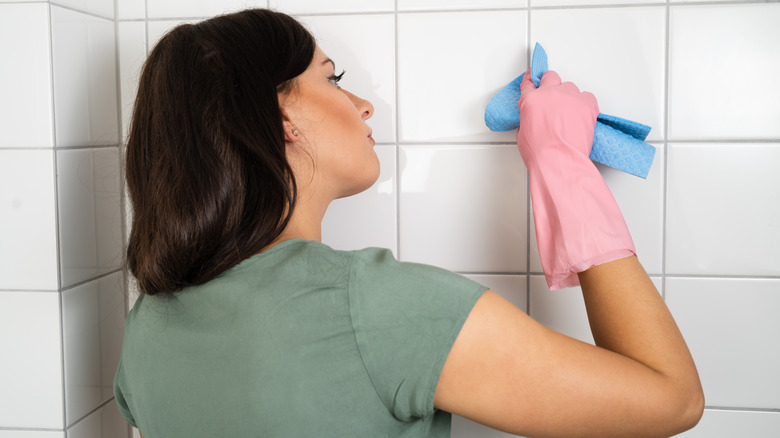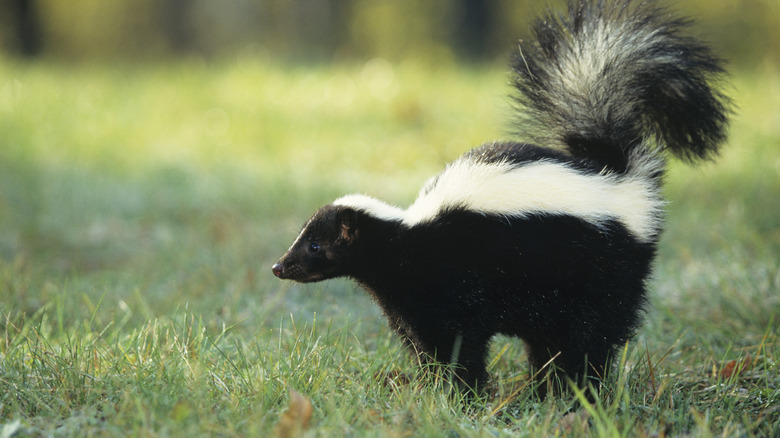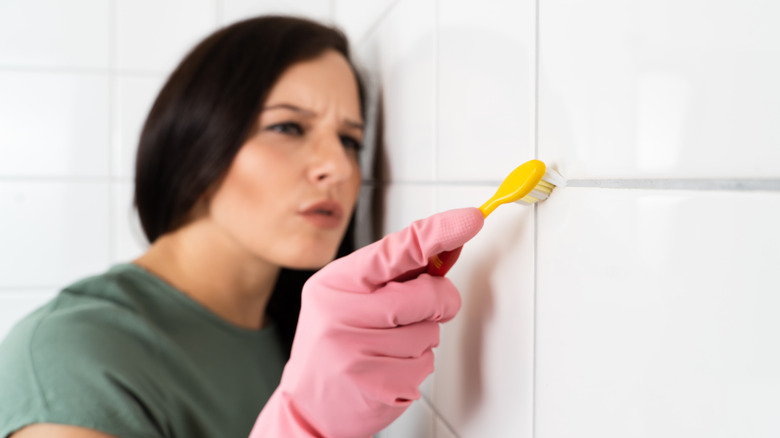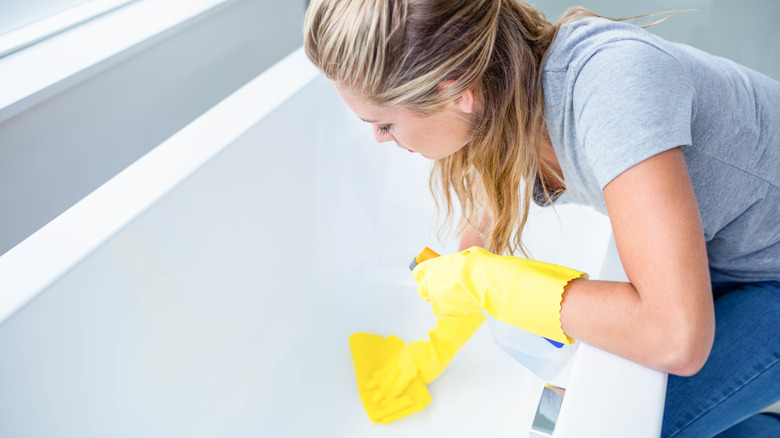6 Ways You Could Be Cleaning With Baking Soda & Hydrogen Peroxide
Baking soda and hydrogen peroxide are common household ingredients that are probably somewhere in your home right now. You've likely used them separately for small tasks like cooking, cleaning, first-aid, and more. But, the magic really happens when you use these products in conjunction with each other, whether they are mixed together or used one after the other. The combination is an inexpensive and nontoxic cleaning solution that is capable of handling some tough projects. Next time you are struggling to whiten your laundry or notice that your tile grout is looking a little worse for wear, consider this dynamic duo.
What is it about hydrogen peroxide and baking soda that makes them a powerful cleaning team? Each ingredient brings a unique set of properties to the table. Baking soda, or sodium bicarbonate, works as both a deodorizer and an abrasive, making it perfect to combat strong odors and stubborn grime. On the other hand, hydrogen peroxide serves as a disinfectant and a mild bleach, helping in everything from disinfecting tubs to whitening laundry. Use them together, and you have yourself a one-two punch that can help you out of tricky messes. Here are all the different ways you can use these natural cleaning ingredients around the house.
Remove skunk odor from clothes
If you or your pet have ever had the misfortune of being sprayed by a skunk, you know firsthand just how hard it is to get rid of the smell of skunk spray. But rather than washing your hair or their fur a hundred times, there is an easier way to tackle that pungent smell. And that is to use a mixture of hydrogen peroxide and baking soda. The spray is made from a yellowish oil that coats everything it touches, making it challenging to dissolve. On top of that, the stench is caused by mercaptans, which are chemicals with sulfur molecules in them, making them reek. However, the mix of these two cleaning products exposes the oil to a heavy dose of oxygen, which helps dissolve the residue and break the chemical bonds in the mercaptans, neutralizing it. You can use this mix on everything from your body to your pet's fur to your clothes.
To DIY the concoction, buy a new bottle of 3% hydrogen peroxide and a box of baking soda, as fresh ingredients work best on such difficult odors. Mix 1 quart of hydrogen peroxide with 1/4 cup of baking soda and 2 tablespoons of Dawn dish soap in an open container, like a bowl. Use it immediately, as storing it can make it explode due to the oxygen buildup. Lather it on your body, in your hair, or on your pet's fur. Leave it on for around 10 minutes if you got heavily sprayed, allowing the oxygen to penetrate. Then rinse it off. You can also use this on clothing, but first spot treat an inconspicuous area to see how the fabric interacts with the mix. Since hydrogen peroxide is a gentle bleaching agent, it might discolor darker clothes.
Effortlessly remove grime from tile grout
Although hydrogen peroxide does not bleach surfaces as effectively as chlorine bleach, it still helps to brighten white areas. However, if you're looking to stop using bleach in your home since it's a harsh, corrosive chemical, hydrogen peroxide and baking soda work particularly well together to brighten white or cream grout. When applied to the grout with a bit of scrubbing action, the slightly abrasive texture of the baking soda will remove stubborn dirt and grime, while the peroxide will lift tough stains. However, this mixture is not so rough that it will begin to break down the grout like bleach could.
Mix 1/2 cup of baking soda with 1/4 cup hydrogen peroxide, and add 1 teaspoon of Castile soap to help dissolve dirt and oils. Using a toothbrush, apply the combined ingredients directly to your grout and start scrubbing. Let it sit for around 10 minutes to penetrate the dirt, and then rinse and dry off your tiles. The end result should be brighter grout lines everywhere from your shower walls to your entryway floor to your kitchen backsplash.
Whiten and brighten dingy porcelain and tiles
Your grout isn't the only thing that can benefit from a mix of hydrogen peroxide and baking soda. So can your tiles and porcelain features, such as the bathtub and sink. Just like with grout, you will mix the two ingredients to create a thick paste that will scrub away buildup, disinfect the surface, and in the case of white porcelain, brighten it to make it feel extra fresh. The baking soda acts as an abrasive in this recipe, its gritty texture loosening stubborn grime, oil, and dried globs of products. (Looking at you, toothpaste stains in the sink.) The hydrogen peroxide, on the other hand, will act as a whitener to help make the bathtub seem less dingy or sink less discolored. More importantly, peroxide is also a reliable disinfectant. That's because it produces damaging free radicals that attack everything from bacteria to viruses to yeast to fungus. Since they're unstable, they bounce around and damage these organisms' cell membranes, effectively killing them.
To scour your tub until it sparkles, begin by mixing 1/2 cup of baking soda with 1/4 cup hydrogen peroxide, and add 1 teaspoon of Castile soap for extra cleaning power. Apply a layer directly to your scrub brush, and using a circular motion and a bit of elbow grease, work away the stains from your tub, sink, and tiles. Allow it to sit for 10 minutes, which not only lets the ingredients lift away dirt, but is mandatory in order for the hydrogen peroxide to disinfect the surface properly. If you see it begin to dry before the 10-minute mark, saturate the surface with another layer in order to eradicate the germs.
Create an effective stain remover
Do you have some tough stains you can't remove with simple soap and water? Maybe your kids drew on the couch with markers, maybe your dining chairs have become dingy with food spills, or perhaps your shirt has a tough spaghetti spot you just can't remove. Luckily, a mixture of hydrogen peroxide and baking soda can cut through the toughest stains. While we can't find the exact science of why this works, it's an old, tried-and-true formula with plenty of time-lapse videos proving it works.
As you can imagine, with any DIY concoction, there are tons of variations in the specific recipe, mainly because different stains will need different ratios. Because of this, play around with your recipe if you don't automatically find success. But to get you started, mix 1 cup of hydrogen peroxide, 1/2 cup of dish soap, and 1/2 cup of baking soda. Pour it into a spray bottle and shake until combined. Apply this mixture directly to your stains, from clothes to furniture to carpets. Rub in the concoction and allow it to penetrate the fabric for 10 minutes. Once the time is up, simply wipe it away with a damp cloth if it's furniture, or throw it into the washing machine if it's textiles. While this works great on white or light-colored fabrics, be careful with darker materials, as the peroxide could discolor them. Always test the mixture on an inconspicuous spot first to see how it reacts. If you're using this recipe with a dark fabric, make sure to wipe away or rinse the solution after one or two minutes not to risk bleaching.
Remove yellow stains from mattresses and pillows
You might be changing your bedsheets and pillowcases regularly, but are you keeping your actual mattress and pillow inserts pristine? Sweat and drool stains happen pretty easily on them, but luckily, hydrogen peroxide and baking soda can help (along with a little help from dish soap). For this tip, you don't want to combine the ingredients together, but rather layer them on top of each other. While we couldn't find the science behind why this works, it is most likely due to the bleaching properties of hydrogen peroxide, abrasive properties of baking soda, and oil-busting properties of dish soap. There are plenty of anecdotal videos that show the yellowed stains disappearing in real time after multiple applications, so it's worth a shot.
To lift stubborn stains from your mattress and pillow inserts, mix 1 cup of hydrogen peroxide with a squirt of Dawn dish soap and pour the mixture into the spray bottle. Saturate the yellow stains, and then pour a thick sprinkling of baking soda on top. Grab a clean toothbrush or hard bristle brush, and begin to gently scrub the stain. Pat it with a damp cloth to remove the residue, and then pat it with a dry cloth to ensure your mattress doesn't become too saturated. Repeat this process several times, until the stain is completely lifted. As is usual with these sorts of home remedies, there are a ton of different recipes and ratios on how to combine these ingredients. Because of this, play around with your ratios until you get the results you need.
Remove yellow stains from white clothing
Do you avoid buying white clothing because it always gets ruined due to sweat stains? Whether white t-shirts get yellowed armpits, white collared shirts get discolored collars, or white baseball hats get the telltale ring underneath the brim, it ruins the appeal of the item. You might be tempted to bleach the stain away, but it actually makes the situation worse since it makes the stain appear darker and more noticeable than ever. However, you don't need to toss that yellowed shirt or hat in the trash just yet. Hydrogen peroxide and baking soda can help.
This works in exactly the same way as the mattress and pillow stain removal trick. And just like with that trick, there are many different variations of the ingredients, with some recipes layering them one after the other, others combining them, some including soap, while others including salt. Because of this, the formula that works best for you might take some experimenting, but they each seem to provide noticeable results. For instance, Maytag recommends creating a paste of 1/2 cup of baking soda, 1 tablespoon of hydrogen peroxide, and 1 tablespoon of salt. Scrub it into the stain with a clean toothbrush, allow it to sit for 20 minutes, and then wash the clothing at the hottest temperature the care tag recommends. Other remedies, like the video above, recommend adding 1 teaspoon of Dawn dish soap, 1 teaspoon of hydrogen peroxide, and 2 teaspoons of baking soda. Add the paste to the stain, allow it to saturate for a few minutes, and then wash it. If the stain is particularly stubborn, allow it to sit for 30 minutes before washing.
You might see some recipes recommending also adding vinegar to the mix, but refrain from adding that. Vinegar and hydrogen peroxide are two cleaning supplies you should never mix, as they create peracetic acid, which is highly corrosive and can severely irritate your eyes and lungs and burn your skin.



